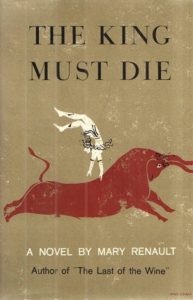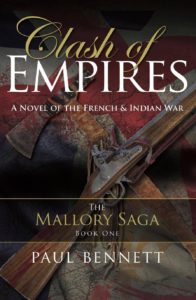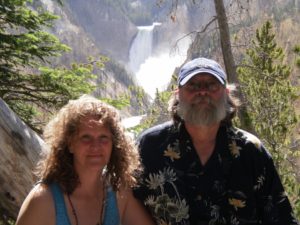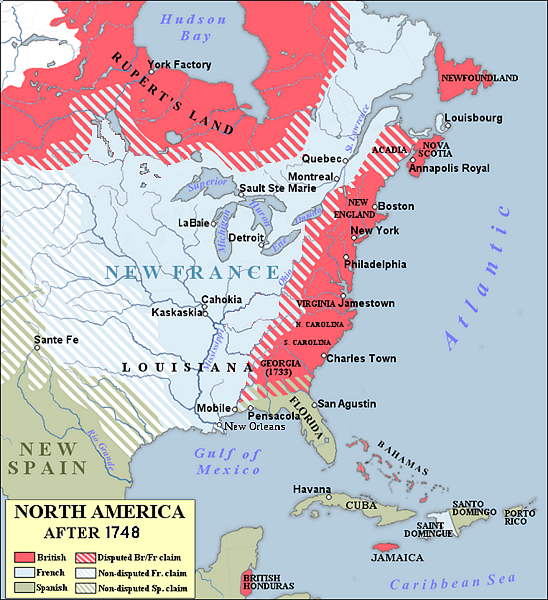Today, my guest is the delightful Paul Bennett who lives in the New England town of Salem, Massachusetts with his wife Daryl and writes historical fiction, the first of which The Clash of Empires is set during the French and Indian Wars.
Discovering his future did not include the fields of mathematics or science, he focused more on his interest in history; not just the rote version of names and dates but the causes. He went on to study Classical Civilization at Wayne State University with a smattering of Physical Anthropology thrown in for good measure. Logically, of course, Paul spent the next four decades drawing upon that vast store of knowledge working in large, multi-platform data centres, and says he is considered in the industry as a bona fide IBM Mainframe dinosaur heading for extinction.
Over to you, Paul!
When Alison asked if I would like to do a guest spot on her blog, I immediately said yes. A few moments later reality set in as I realized I didn’t know what I would blog about. I have written one book, so I don’t think of myself as an expert on the subjects surrounding being a good author. For example, I frequently see advice on how to develop a systematic approach to writing, and then I look back on how I approach it. My, oh my, it’s a miracle I finished the book in a manner that is coherent. 🙂 Or, a how to on character development; again I plead ignorance and amazement at my results.
So, after mulling over the possibilities for a couple of days, my Muse whispered in my ear that instead of a how to blog, I should write a why blog. Why do I write historical fiction; why did I choose The French and Indian War as a subject? The root or genesis of the first question lies at the feet of Kirk Douglas and Tony Curtis. Spartacus and other movies of the time like Ben Hur, The 300 Spartans, and Cleopatra kick-started an interest in ancient times. This led to my reading about Heinrich Schliemann and his discoveries at Mycenae, and at Troy. I was hooked on history from then on. In high school, I elected history classes when given a choice; my favorite being an advanced American History class where I found that the causes were more important to learn rather than just the results. My major at Wayne State University was Classical Civilization; a curriculum that required the learning of Ancient Greek, so I must have been serious about it. 🙂
 The fictional aspect came from Mary Renault’s The King Must Die. That was the first book that showed me that historical events could be rendered into fiction, albeit in this case mythological history. What an eye opener, and one that propelled me into a voracious frenzy of reading and learning; a situation that has not abated over the decades. Indeed, the number of talented historical-fiction authors I have come across over the years is truly astounding.
The fictional aspect came from Mary Renault’s The King Must Die. That was the first book that showed me that historical events could be rendered into fiction, albeit in this case mythological history. What an eye opener, and one that propelled me into a voracious frenzy of reading and learning; a situation that has not abated over the decades. Indeed, the number of talented historical-fiction authors I have come across over the years is truly astounding.
Through the medium of social networking I have become friends with many of those authors, and it is because of them that I not only started a book review blog (see the link below), but also began my journey to producing Clash of Empires; the first book in my series, The Mallory Saga. Thus, we come to the second question; why that subject. The French and Indian War seemed to me to be the perfect historical event to begin my ambitious idea to portray the history of this country through the eyes of a fictional family, the Mallorys. This was a worldwide, cataclysmic event; indeed some have called it the real First World War as it was fought not only here in America, but also in Europe, and the West Indies. It also proved to be rather costly for the British even though they won the war. The subsequent taxation and trade policies with the American colonies set the stage for revolution.
In Clash, I was able to incorporate the historical events with a fictional spin; staying true to the history but seen through the eyes and actions of my fictional frontier family. A great deal of the action in the war took place in western Pennsylvania, and much of that at Fort Duquesne; modern day Pittsburgh. The Mallorys were settled in that area before the outbreak of the war and become intimately involved in the conflict. One of the big challenges I found was keeping true to the nature and speech of the historical figures; a young George Washington leading his first militia command, General Braddock leading his force into a deadly trap. A challenge, yes, but at the same time a whole lot of fun.
One thing I have learned while writing Clash is that the characters I created, that I gave life to, often have minds of their own. I’ll have an idea where I want a particular passage, scene, or conversation to go, but when I start writing that bit something happens. It’s as if my characters have hijacked my fingers and voilà, a new idea is born. I suspect that this activity on the part of my characters is part of a conspiracy concocted and led by my feisty Muse. She seems to delight in surprising me, often while I am driving to and from work. Just the other day I spied a bald eagle flying overhead as I was passing Minuteman National Park, the site of the famous battle of Lexington and Concord that began the Revolutionary War. I know that was my Muse in the guise of an eagle, scouting out the area for the chapter I was soon to write about that battle.
Despite all of the challenges facing the historical fiction author, I have found it an exhilarating experience. A chance to not only entertain, but perhaps even to teach. I hope I have achieved that in Clash of Empires.
Thank you, Paul!
About Clash of Empires
 1756 – Britain and France are on a collision course for control of the North American continent that will turn into the first truly world war, known as The Seven Years’ War in Europe and The French and Indian War in the colonies. The Mallory family uproots from eastern Pennsylvania and moves to the western frontier only to find themselves in the middle of war.
1756 – Britain and France are on a collision course for control of the North American continent that will turn into the first truly world war, known as The Seven Years’ War in Europe and The French and Indian War in the colonies. The Mallory family uproots from eastern Pennsylvania and moves to the western frontier only to find themselves in the middle of war.
Three siblings, Daniel, Liam and Liza, are caught up in the conflict and endure emotional trauma. Their story is woven into historical events such as the two expeditions to seize Fort Duquesne from the French and the fighting around Forts Carillon and William Henry. We meet historical characters George Washington, Generals Braddock, Forbes and Amherst. The book also includes Pontiac’s Rebellion in which the Mallorys play important roles. Clash of Empires explores events running up to July 1776, events that will be chronicled in the second book, Paths to Freedom as I follow the exploits and fate of the Mallory clan.
You can buy Clash of Empires on Amazon.com Amazon.co.uk
Read Paul’s excellent book review blog
Connect with Paul on Twitter: hooverbkreview
Alison Morton is the author of Roma Nova thrillers INCEPTIO, PERFIDITAS, SUCCESSIO, AURELIA, INSURRECTIO and RETALIO. CARINA, a novella, is available for download now. Audiobooks are available for the first four of the series.
Find out more about Roma Nova, its origins, stories and heroines… Get INCEPTIO, the series starter, for FREE when you sign up to Alison’s free monthly email newsletter















[…] https://alisonmortonauthor.com/2017/12/meet-paul-bennett-writer-of-american-historical-fiction/ […]